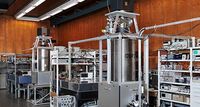Microwave Generation for Atomic Frequency Standards
Using frequency combs for low-phase-noise microwave signal generation

- Generating low-phase-noise microwave signals for atomic frequency standards
- High long-term stability and reliability
- Also important for radar, remote sensing, communications, navigation and high-speed electronics
- Frequency combs enable generation of microwave signals with ultra-low noise
Low-phase-noise microwave signals with high long-term stability and reliability are very important for today’s atomic frequency standards where the phase noise of the interrogation oscillator can affect the stability of the clock (Dick effect). But also technologies like radar and remote sensing, communications and navigation, high-speed electronics, very long baseline interferometry, and high-precision timing distribution and synchronization benefit from better and more robust microwave sources.
Best microwave sources
Until recently, the best microwave sources achieving low noise performance were ultralow-noise quartz oscillators or cryogenic sapphire oscillators. The latter one is outperforming the quartz oscillators by orders of magnitude. But it comes with the need to operate at cryogenic temperatures, which significantly increases the complexity and the cost of ownership of such sources.
Using a frequency comb as "optical frequency divider" one can transfer the stability of ultra-stable optical oscillators like high finesse cavity-stabilized lasers from the optical regime into the microwave regime. A comb line of the frequency comb is phase locked to the cavity-stabilized laser and a harmonic of the repetition rate is detected. Because of the phase lock, the repetition rate of the frequency comb is phase coherent with the signal from the cavity-stabilized laser but divided down in frequency by a large factor on the order of 105-106. This method achieves an exceptionally low phase noise.
The robustness and ease of use of Er:fiber frequency combs is advantageous for the implementation of compact, mobile microwave sources. Since Er:fiber combs operate in the telecom wavelength range they are also beneficial for largescale pulse distribution. Values as low as −111 dBc / Hz at 1 Hz offset from a 11,55 GHz carrier or −175 dBc ∕ Hz at 10 MHz offset from a 10 GHz carrier have been achieved with fiber combs[1,2]. Optical pulse interleaving, where an optical pulse train is split and recombined with a half-period delay, is a stable and efficient method to achieve repetition rate multiplication of fiber frequency combs to values on the order of 10 GHz. This technique increases the signal level of the photodetected microwave signal and thereby improves the signal to noise level[2,3].
Today's use
Optically generated microwave signals will play an important role in many future low noise applications. Today, microwave signals used for the interrogation of some primary cesium fountain clocks, which contribute to the worldwide reference time scale UTC (Coordinated Universal Time) have already been migrated towards frequency synthesis schemes based on “optical microwaves”[4]. The picture above shows the cesium fountain clocks operated at the Physikalisch-Technische Bundesanstalt (PTB) in Braunschweig, Germany.
European Quantum Flagship Projects

German Quantum Technology Projects

-
Related Products
-
Related Applications
-
Related Literature
- 1. Millo et al., Ultra-low-noise microwave extraction from fiber-based optical frequency comb, Opt. Lett. 34 (2009)
- 2. Quinlan et al., Optical amplification and pulse interleaving for low-noise photonic microwave generation, Opt. Lett. 39 (2014)
- 3. Haboucha et al., Optical-fiber pulse rate multiplier for ultralow phase-noise signal generation, Opt. Lett. 36 (2011)
- 4. Lipphardt et al., Optical Stabilization of a Microwave Oscillator for Fountain Clock Interrogation, arXiv:1609.05718v1 (2016)
